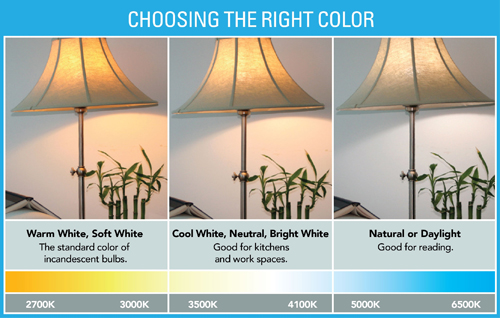How can I make the lighting in my home more energy-efficient?
The energy efficiency and lifespan of light bulbs have come very far in a short time. LED bulbs are up to 90% more energy efficient than incandescent lights, and last at least 15 times longer. Here are some tips and tools on how you can effectively light your home in an energy-efficient way.
Look for the ENERGY STAR® label

When you need to purchase new light bulbs, look for bulbs that are ENERGY STAR® certified. Only bulbs that have earned the ENERGY STAR® label have gone through extensive testing and verification that they will save energy and perform as promised.
Source: ENERGY STAR®
Consider the brightness needed for different areas of your home
The brightness of LED light bulbs is measured in lumens or light output, unlike incandescent bulbs that are measured by watts or energy consumed. Use this chart to determine how many lumens you need to match the brightness of your old incandescent bulbs.
OLD INCANDESCENT BULBS | ENERGY STAR® BULB BRIGHTNESS |
|---|---|
| 40 | 450 |
| 60 | 800 |
| 75 | 1,100 |
| 100 | 1,600 |
| 150 | 2,600 |
Remember that different bulbs cast light in different colours
- Light colour is measured on the Kelvin (K) temperature scale. Lower Kelvin numbers mean the light appears softer and more yellow. Higher Kelvin numbers indicate the light is brighter and appears more white or blue.
- Most ENERGY STAR® certified bulbs are made to match the colour of incandescent bulbs at 2700-3000K. For a whiter light, look for bulbs marked 3500-4100K. For bluer white light, look for bulbs marked 5000-6500K.

Understand the differences between incandescent, CFL and LED light bulbs
This chart outlines the general differences among incandescent, CFL and LED lights. But, please note that all products are different. Always check the product packaging to make sure you’re purchasing the right bulb for your needs.
| Incandescent | CFL | LED |
|---|---|---|---|
Typical Lifespan | 1,000 hours | 10,000 hours | 25,000 hours |
Lumens (Light Output) | |||
|---|---|---|---|
450 | 40 watts | 9-13 | 4-8 watts |
800 | 60 watts | 13-16 watts | 7-12 watts |
1600 | 100 watts | 23-27 watts | 16-20 watts |
Turns on Instantly | Yes | No - Takes time to warm up. | Yes |
Issue with On/Off Cycling (Switching the light bulb on and off frequently) | Some | Yes - Can significantly reduce the bulb’s lifespan. | No effect |
Operate in cold temperatures | Some | Yes - May not work in very cold temperatures. Always check the packaging. | Yes - Always check the packaging. |
Heat Emitted | High heat | Moderate heat | Very minimal/no heat |
Contains Mercury | No | Yes - CFLs contain a small amount of mercury. CFLs should be disposed of in an environmentally-friendly way. | No |
Install dimmer switches on your lights
- Use a dimmer switch to control the intensity and amount of light you need. Turning down the light level can save electricity and extend the life of light bulbs.
- Dimmers work with all incandescent light bulbs, most LEDs, and some CFL light bulbs. Look for specially marked CFLs and LEDs that are designed for use with a dimmer switch.
- Before installing the dimmer switch, check to see if the bulbs you’re using are compatible with that dimmer. New dimmer switches will tell you if they are compatible with LED bulbs.
Install Motion Sensors
- Use a motion sensor to automatically turn off the lights in rooms where the lights don’t have to be turned on all the time or rooms where you may forget to turn off the lights. Many motion sensors can be programmed to shut off lights when there is no movement in an area after a predetermined time.
- Improve the security of your home by automatically lighting up hallways and garages with a motion sensor. These devices replace your standard light switch and can be directly wired to your light(s).
- Although indoor motion sensors cost more than regular light switches, they can significantly reduce your electricity usage immediately and over the long term.
Install a light timer
- To save electricity, use a light switch timer to control the amount of time the lights are on in a specific room or outside.
- Program some timers to turn on and off intermittently. This will save electricity and enhance your family’s security when family members come home after dark or when the family is away.
- Program timers to turn-on or shut-off at designated times so lights are on only when they are required.